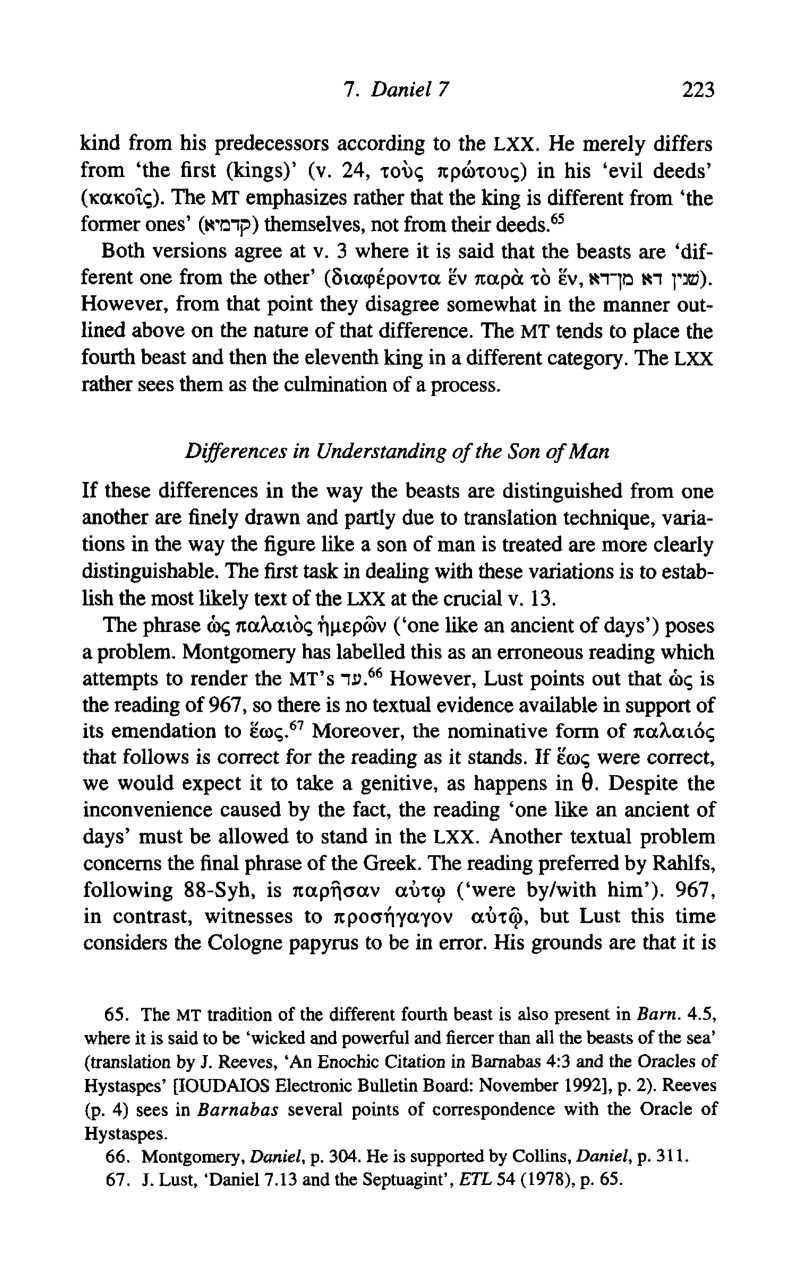T. J. Meadowcroft discusses various textual differences in Greek manuscript tradition of Daniel 7.
- Type
- Book
- Source
- T. J. Meadowcroft Non-LDS
- Hearsay
- DirectSecondary
- Reference
T. J. Meadowcroft, Aramaic Daniel and Greek Daniel: A Literary Comparison (Journal for the Study of the Old Testament Supplement Series 198; Sheffield: Sheffield Academic Press, 1995), 223-24
- Scribe/Publisher
- Sheffield Academic Press
- People
- T. J. Meadowcroft
- Audience
- Reading Public
- Transcription
Differences in Understanding of the Son of Man
If these differences in the way the beasts are distinguished from one another are finely drawn and partly due to translation technique, variations in the way the figure like a son of man is treated are more clearly distinguishable. The first task in dealing with these variations is to establish the most likely text of the LXX at the crucial v. 13.
The phrase ως παλαιος ημερων (‘one like an ancient of days’) poses a problem. Montgomery has labelled this as an erroneous reading which attempts to render the MT’s HEB. However, Lust points out that ως is the reading of 967, so there is no textual evidence available in support of its emendation of εως. Moreover, the nominative form of παλαιος that follows is correct for the reading as it stands. If εως were correct, we would expect it to take a genitive, as happens in Θ. Despite the inconvenience caused by the fact, the reading ‘one like an ancient of days’ must be allowed to stand in the LXX. Another textual problem concerns the final phrase of the Greek. The reading preferred by Rahlfs, following 88-Srh, is παρησαν αυτω (‘were by/with him’). 967 in contrast, witnesses to προσφγαγον αυτω, but Lust this time considers the Cologne papyrus to be in error. His grounds are that it is grammatically incorrect, and has come about as a corruption from Θ/MT. In fact, there does not need to be a grammatical problem with the 967 reading. The προσαγω, used intransitively with αυτω as its indirect object. Hence, ‘they (the bystanders) draw close to him’. Other occurrences of this form in the LXX may be found in Num. 7.3 and 15.33 as well as Susanna 52. If there has been no cause to doubt the reliability of 967 for the rest of v. 13, there seem to be no grounds for rejecting it at this point. Indeed, the whole verse makes adequate grammatical sense as presented by 967. The sense is as follows: ‘on the clouds of heaven one like a son of man came and one like an ancient of days was nearby, and those standing by drew near to him’. That is the meaning presumed for the rest of this discussion.
- Citations in Mormonr Qnas
The B. H. Roberts Foundation is not owned by, operated by, or affiliated with the Church of Jesus Christ of Latter-day Saints.

